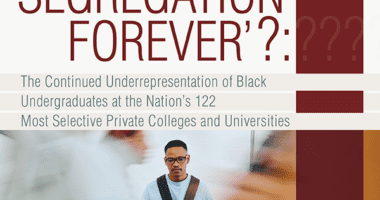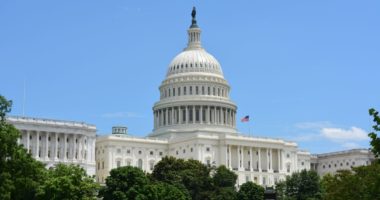Under-Representation of Black, Latino, and Native American Undergraduates at Four-Year Universities: A Nationwide View
In 2020, EdTrust released a report titled, “Segregation Forever?,” which found that Black and Latino students are grossly underrepresented at selective public colleges and universities in states compared to their respective state demographics.
Last month, we published a new report that picked up where that one left off and examined enrollment for these same student groups at the nation’s 122 most selective four-year private colleges and universities. This time around, we compared Black and Latino enrollment at elite private institutions in the years 2000 and 2020 against the number of Black and Latino (18- to 24-year-old) residents of states from which the first-time students had come. The results weren’t great: Less than 16% of elite private colleges enroll representative shares of Black undergraduates, and only 9% enroll representative shares of Latino students.
These findings suggest that students of color are still severely under-represented at higher education institutions and progress has been slow. But we wanted to know more. We decided to dig deeper to provide a more holistic set of data about how students of various races and ethnicities experience college access at the nation’s four-year colleges and universities, so advocates, policymakers, and college leaders can get a better sense of what’s happening and do something about it. We built a dashboard that examines enrollment patterns and representation of students across seven different races and ethnicities at all four-year higher education institutions in the U.S., including public and private universities, and provides access scores for all four-year colleges and universities nationwide.
Here’s what our analysis of college access for undergraduate students from seven different races/ethnicities across the nation’s four-year higher education institutions uncovered:
Black undergraduate access in 2020:
- The median access score for public institutions was 62 (equivalent to an F).
- Slightly more than 1 in 4 (28%) public institutions scored A’s for access, while just under half (47%) got failing grades.
- The most accessible non-HBCU public institutions were CUNY Medgar Evers College, Chicago State University, and Montana State University – Northern.
- A little more than half of public institutions (362 out of 669) failed to meet benchmarks in 2000 and 2020 and would have needed an average annual growth rate of 7.48% in Black enrollment to hit those benchmarks.
- At selective public institutions, the average gap in enrollment and benchmarks has increased by 3.99 percentage points since 2000 (-4.02% to -8.01%).
Latino undergraduate access in 2020:
- The median access score for public institutions was 75 (equivalent to a C).
- A little more than 1 in 3 (32%) public universities scored A’s for access, while another third (29%) got failing grades.
- The most accessible universities were Indiana University – Northwest, Dalton State College, and CUNY Lehman College.
- More than half of public institutions (385 out of 669) failed to meet benchmarks in 2000 and 2020 and would have needed an average annual increase of 6.3% in Latino enrollment to meet them.
- At selective public institutions, the average gap in enrollment and benchmarks has shrunk by 2.01 percentage points since 2000 (-9.59% to -7.58%).
Native American/Alaska Native undergraduate access in 2020:
- The median access score for public institutions was 53 (equivalent to an F).
- Only 1 in 4 (25%) public institutions earned A’s for access, while more than half (56%) earned F’s.
- The most accessible non-tribal institutions were Fort Lewis College, Louisiana State University – Alexandria, and Lake Superior State University.
- About 40% of institutions (273 out of 669) failed to hit their benchmarks in 2000 and in 2020 and would have needed an annual 1.1% increase in Native American/Alaska Native enrollment to meet those benchmarks.
- At selective public institutions, the average gap in enrollment and benchmarks has increased by 0.27 percentage points since 2000 (-0.33% to -0.60%).
These findings aren’t surprising, but they should concern policymakers, advocates, and higher education leaders, as the U.S. is becoming more diverse, and this issue is increasingly salient. What’s more, things could get worse now that the Supreme Court has all but outlawed the use of race in college and university admissions and right-wing lawmakers are going after diversity, equity, and inclusion (DEI) initiatives.
To counter this trend, colleges and universities will need to find creative ways to ensure that they are enrolling representative shares of Black, Latino, and Native American/Alaska Native students on their campuses and fostering inclusive campus environments for students, as these are crucial to dismantling persistent segregation in higher education and ensuring that all students have equal opportunities. Policymakers, educational institutions, and community stakeholders will also need to make concerted efforts to create a more inclusive and equitable higher education system.
Here are some of our recommendations to increase accessibility:
- Develop recruitment strategies that increase access
- Improve campus racial climates
- Increase access to high-quality guidance counselors
- Increase accountability from accreditors and accreditation organizations
- Increase aid to Black, Latino, and Native American/Alaska Native students
- Leverage federal accountability
- Reduce the role of standardized testing and/or consider making tests optional
Resources
Click here to view the Dashboard Guide.
See previous reports:









